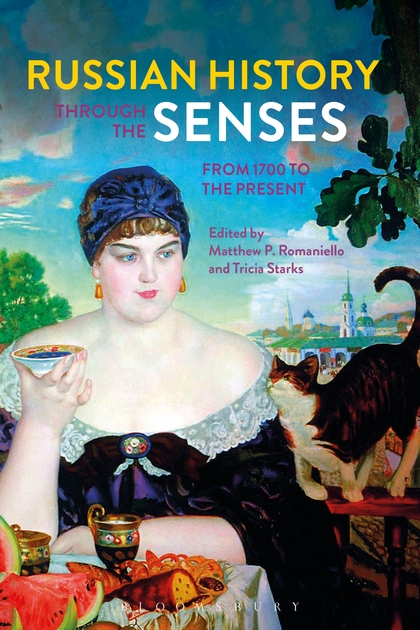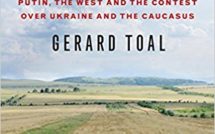
Russian History through the Senses: From 1700 to the Present, edited by Matthew P. Romaniello and Tricia Starks
 This is part of our special feature, Diversity, Security, Mobility: Challenges for Eastern Europe.
This is part of our special feature, Diversity, Security, Mobility: Challenges for Eastern Europe.
This edited volume is a sampler offering a taste of the sensory history of Russia from the early imperial era through the late Soviet period (contrary to what the subtitle claims, there is only one page on the post-Soviet era). The articles in the book are of uniformly high quality, each richly informative.
The authors acknowledge that their work rests on the scholarly foundations laid by the leading practitioners of sensory history, most notably Alain Corbin, Martin Jay, and Mark M. Smith. As Alexander M. Martin’s introduction notes, the theoretical ancestry of the book goes back even further, to Walter Benjamin and Norbert Elias, both of whom integrated sensory elements into their socio-cultural analyses; Michel Foucault, who discerned arelationship between power, the body, and the senses; and Maurice Halbwachs and Pierre Nora, pioneer scholars of national identity and historical memory. Class and gender play supporting roles in this book, but above all these articles offer a refined probing of historical mentalities, or what Tim Harte, in his article on the smells of Stalinism in the films of Aleksei German, Sr., refers toas the link between the senses and “semiological processes” (280).
As I see it, two leitmotifs recur throughout the book. First, every article that traces its subject to the prerevolutionary era indicates the significant continuities that persisted across the 1917 divide. Second, most of the articles suggest resemblances between Russian and Western patterns of behavior, thus adding support for the once-controversial thesis that Russian history can be understood not as a deviation from the rest of Europe’s but in close connection with it. Illustrating this point is Anton Masterovoy’s important and entertaining essay, “Engineering Tastes: Food and the Senses,” about tsarist and Soviet-era nutritional reformers’ unsuccessful efforts to change Russian taste preferences. When beef and pork were in short supply, they tried in vain to convince the populace to adopt soy-based foods—which their propaganda called “the miracle bean” and “the Revolutionary Chinese woman” (171), and in different decades pontificated about the virtues of serving rabbit, horse meat, dolphin, whale meat, quark, fish sausage, or a dreadful laboratory concoction reminiscent of American “prison loaf” called “Proteinic Product of the Nutritional Institute of the Academy of Medical Sciences of the USSR” (180). With some obvious differences, this paralleled similar campaigns in Europe, and to a lesser extent the United States, at various times in the twentieth century. In one respect, at least, the Soviet Union exhibited greater acceptance of difference than any Western nation did. As Claire Shaw’s contribution, “Deafness and the Politics of Hearing,” makes clear, the Soviets did not apply eugenicist practices to deafness, and the deaf community was able to adopt sign language and resist pressures emphasizing speech even in the Stalin era.
What do we gain from looking at Russian history through the senses? On one level, it places front and center certain realities that are taken for granted or ignored in the scholarly literature. For instance, the cold climate that shocked the systems of early modern visitors from the West, as chronicled in Matthew P. Romaniello’s entry. Paying attention to the senses can also open our eyes to a new dimension of warfare, which is vividly illustrated in articles by Laurie S. Stoff on nurses in World War One and Steven G. Jug on soldiers in World War Two. In Stoff’s words, “adding auditory, olfactory, tactile, and gustatory perceptions to analysis of [war] is significant because often these senses were vital in shaping wartime experience and memory in ways beyond mere visual recollection” (119). The same could be said of any other realm of life, too.
The other reason this subject is worthy of exploration was hinted at in George Orwell’s The Road to Wigan Pier (1937), when he explained:
The real reason why a European of bourgeois upbringing, even when he calls himself a Communist, cannot without a hard effort think of a working man as his equal. It is summed up in four frightful words which people nowadays are chary of uttering, but which were bandied about quite freely in my childhood. The words were: The lower classes smell…. And here, obviously, you are at an impassable barrier. For no feeling of like or dislike is quite so fundamental as a physical feeling. Race-hatred, religious hatred, differences of education, of temperament, of intellect, even differences of moral code, can be got over; but physical repulsion cannot…. It may not greatly matter if the average middle-class person is brought up to believe that the working classes are ignorant, lazy, drunken, boorish, and dishonest; it is when he is brought up to believe that they are dirty that the harm is done. And in my childhood we were brought up to believe that they were dirty.
It has taken historians a long time to come to grips with sentiments like these, but over the past decade they have begun to investigate how the senses function as keys to social demarcation, self-identification, and distancing from other classes, ethnic groups, and cultures. It is an age-old story if one thinks about one of the purposes of religious dietary laws. But it is especially common as a condition of modern times, when a heightened awareness of these behaviors was made possible by new communications technologies, consumption opportunities, and mixing of social classes. What is nationalism, after all, but a self-conscious ideology of difference resting on unique sights, sounds, and tastes? These issues are well trodden in the historical literature on Russia, but the articles in this volume, with their focus on the senses, offer penetrating insights into them.
Most of the entries here contend with distancing between groups within Russian society, while others follow the senses to locate the mental demarcations between Russia and the West. In the internal category, Abby Schrader’s article on “market pleasures and prostitution in St Petersburg” depicts the construction in 1848 of the Passazh off Nevsky Prospekt as an attempt to create an orderly world separate from the “slovenly” (67, 73), putrid-smelling, and noisy Russian markets where the lower-class rabble thronged. With rapid urbanization came constant physical interaction of the social estates, which produced anxiety among the well-to-do. The Passazh arcade, with its controlled space and luxury shopping, offered the elite the seeming opportunity to fence itself off from the masses. But it was an illusion: the modern world does not function that way, and besides, the Passazh attracted prostitutes as well as independent women, both perceived as a threat to the social order by the scolding, male-dominated press.
Similarly, concerned with internal social relations are articles by Tricia Starks and Aaron B. Retish. Writing on “the taste, smell, and semiotics of cigarettes,” Starks analyzes smoking as a “sign of cultivation—a key means of marking status” (106). Tobacco advertisements featuring African-Americans and Orientalized images of scantily clad Turkic women heightened this cosmopolitan self-fashioning of the middle and upper classes by associating smoking with the wider world. Retish, giving equal time to both the late tsarist and early Soviet periods, delves into the fate of kumyshka, the moonshine of the Udmurts and other indigenous Finno-Ugrian populations of the upper Volga region. “Kumyshka and the physical sensations it elicited,” he writes, “became a totem for multiple populations in late imperial and early Soviet Russia to debate confession, modernity, national culture, and contagion” (141). Alleged to be primitive and unsanitary, this home brew mainly distilled by women for animist religious rituals offended the sensibilities of intellectuals, incensed Orthodox missionaries, and frustrated the centralizing ambitions of political operatives who sought to impose “cultural enlightenment” (155) on this ethnic group, which faced such pressures both before and after the revolution. The Udmurts were defiant, but it was largely for naught when confronted with Soviet class-based divide-and-rule tactics and brutal coercive measures.
A few of the articles also address the perceived sensory distinctions between Russia and the West. According to Romaniello, in the only piece that approaches its subject from the Westerners’ point of view, the foreign experience of the cold in Russia was so striking, not just because of the physical impact, but also because of Europeans’ assessment, informed by flawed scientific theories of the humors, that Russians were physically deficient. As he states, the Russian cold “was not only a physical reality, but also a cultural construct” (38). Alison K. Smith, in her article on “Fermentation, Taste, and Identity,” shows how significantly the Russian fondness for sour tastes, epitomized by what she calls the trinity of rye bread, kvas, and fermented cabbage, diverged from those in the West. Foreign travelers could not seem to get used to them: as a Scottish traveler wrote, “this kvas is the thinnest, sourest, queerest kind of stuff ever concocted” (53). Many westernized Russians also disparaged those foods, but inspired by gastronomic nationalism, cookbook authors and nutritionists increasingly touted them as superior to European cuisines.
Finally, Adrienne Harris’ innovative study of the evolving representations of the World War II martyr Zoia Kosmodemianskaia, maintains that this external distancing has persisted to the present. In Harris’ words, her case study “demonstrates clearly how sensory studies might enrich our understanding of memory, memorialization, and mythopoesis, especially within an authoritarian state in which individuals must mediate official messages for themselves” (262). Disturbing images and statues of the mutilated body of Zoia led her compatriots on the home front during the war to imagine how she sounded and what she felt, and by extension to comprehend viscerally what the Nazis did to their nation. For contemporary political purposes, new statuary and memorials to her continue to instruct Russians from school age on that their people suffered and sacrificed not so long ago because of foreign enemies.
Along those lines, Harris’ article makes one wonder what application of the approach taken in this book would reveal more generally about internal social divisions in Putin’s Russia.Attraction and repulsion toward the West are features of the post-Soviet era just as they were of the Imperial and Soviet periods, but complicated by increased global interactions.As the entire book demonstrates, sensory history can help us to see more subtle gradations of color in that spectrum of attitudes past and present.
Reviewed by Steven G. Marks, Clemson University
Russian History through the Senses: From 1700 to the Present
by Matthew P. Romaniello and Tricia Starks
Publisher: Bloomsbury Academic
Hardcover / 320 pages / 2016
ISBN: 978-1474263122
To read more book reviews, please click here.
Published on December 6, 2017.




